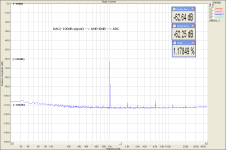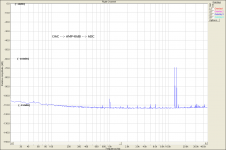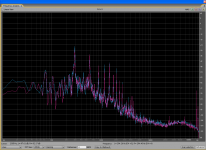I want to thank people here for effectively encouraging me to tweak the PC audio setup -
It is very good that these 'listening' threads might be helpful or encouraging, they are just little bit different from other almost pub-like discussion, I am referring to BT thread.
That was a fluke of chance, but I had the same experience.Interesting test, what made the noise become noticeable was tuning into the brushwork - the noise, and the dragging of the brushes on the drum surface match in character, so when the tonality of the latter significantly alters the noise is becoming noticeable.
A test like this shows that 16 bit is more than enough for reproduction.
It would be great if we can use those test signals to.Can't try right now. The nature of the noise is also very significant: random noise not so bad, ground loop noise containing a mishmash of periodic signals very damaging. Z contains non random warble sound.
A test like this shows that 16 bit is more than enough for reproduction.
I respectfully disagree.
On the other hand, most of the cheap 24bit chips built in PC's have in fact worse parameters than a good external 16-bit DAC. Then I agree that 16-bit replay may have even higher quality than 24-bit mediocre replay. But, in case of high quality recording, the 24-bit is superior, especially with 96kHz or higher sample rate. The tests performed on toys are insufficient for confirmation or disagreement.
Pavel, with regard to your belief there, could you nominate a music track - not test signal - that is freely available on the net that demonstrates that. IOW, either it is 24 bit, and reducing it to 16 bits "loses something" - or a 24 bit replay chain shows clear superiority in some audible area in replay, compared with a 16 bit replay chain of comparable quality.
Then where can you here the noise start to appear?I respectfully disagree.
Vinyl and tape playback seem to be favourites among those bashing redbook. The noise level of those formats never seems to be an issue, why should the noise level of redbook be a problem?
Yes please Pavel. Me too. 🙂Pavel, with regard to your belief there, could you nominate a music track - not test signal - that is freely available on the net that demonstrates that. IOW, either it is 24 bit, and reducing it to 16 bits "loses something" - or a 24 bit replay chain shows clear superiority in some audible area in replay, compared with a 16 bit replay chain of comparable quality.
To test the DAC performance, I use additional +40dB analog amplifier. The reason is that my ADC is worse in parameters than the DAC. Example of DAC measurement is attached. The test chain is DAC (fed with -100dBFS signal) --> analog amplifier +40dB --> ADC. So the plot must be 'moved' 40dB down, for the reason of +40dB amplification. In brackets are already moved dB values. DAC output at FS provides -2.7dBFS measured with ADC, so therefore the dB value is not -60dB as expected but about -62.7dB. And yes, this arrangement has groundloop 😉. 0dBFS input of ADC refers to 2Vrms. Also please notice that -100dB DAC signal has only about 1% harmonic distortion .....
Attachments
Pavel, with regard to your belief there, could you nominate a music track - not test signal - that is freely available on the net that demonstrates that. IOW, either it is 24 bit, and reducing it to 16 bits "loses something" - or a 24 bit replay chain shows clear superiority in some audible area in replay, compared with a 16 bit replay chain of comparable quality.
Yes please Pavel. Me too. 🙂
Good recordings of classical music. I buy from Linn records, the data have to be bought, they are not available for free.
This is fine, there's nothing wrong with objective measurements.To test the DAC performance, I use additional +40dB analog amplifier. The reason is that my ADC is worse in parameters than the DAC. Example of DAC measurement is attached. The test chain is DAC (fed with -100dBFS signal) --> analog amplifier +40dB --> ADC. So the plot must be 'moved' 40dB down, for the reason of +40dB amplification. In brackets are already moved dB values. DAC output at FS provides -2.7dBFS measured with ADC, so therefore the dB value is not -60dB as expected but about -62.7dB. And yes, this arrangement has groundloop 😉. 0dBFS input of ADC refers to 2Vrms. Also please notice that -100dB DAC signal has only about 1% harmonic distortion .....
But the proof of the pudding is in the eating, so we need subjective measurements.
Can you positively ABX a normal music file with no white noise added vs a file that has white noise added at -80dBfs?
IIRC, Lindberg Lyd (2L - the Nordic Sound) have some high bit rate classical music available as free downloads. I used one of their 24/192 recordings a lot while troubleshooting my Raspberry Pi setup. You could downsample these yourself and do an ABX test. (Don't forget to dither properly 🙂 )
"24 bit" is more a marketing term than anything else. For example, the new PCM5102A DAC chip claims to be 32 bit, but it also claims a SNR of 112dB which is only something like 19 effective bits.
Even though most of my music collection is 44.1/16, I like to use the highest quality DAC I can in the hope of getting at least 16 functional bits.
"24 bit" is more a marketing term than anything else. For example, the new PCM5102A DAC chip claims to be 32 bit, but it also claims a SNR of 112dB which is only something like 19 effective bits.
Even though most of my music collection is 44.1/16, I like to use the highest quality DAC I can in the hope of getting at least 16 functional bits.
Last edited:
IIRC, Lindberg Lyd (2L - the Nordic Sound) have some high bit rate classical music available as free downloads. I used one of their 24/192 recordings a lot while troubleshooting my Raspberry Pi setup. You could downsample these yourself and do an ABX test. (Don't forget to dither properly 🙂 )
There is one big problem here.
Lots of converters give of switching clues when changing formats, so that can give a false positive.
What you need to do is add noise to the high resolution file and try to ABX that.
Pavel, sorry to add some more distraction, and negativity to the situation, but I wanted to at least get some more clarity on what was possible - I immediately had misgivings about RMAA, and this link mentions these, plus much, much more: NwAvGuy: RightMark Audio Analyzer
Most of the problems described here are really problems with the whole idea of using a soundcard to make measurements, not the RMAA software itself.
When I was building solid-state power amps, I got the distortion low enough that I couldn't measure it with a soundcard any more. I ended up getting an analog notch-type distortion analyser. Even quite an old and cheap one performs better than a soundcard in some ways.
There is one big problem here.
Lots of converters give of switching clues when changing formats, so that can give a false positive.
What you need to do is add noise to the high resolution file and try to ABX that.
I would downsample it and then upsample again to the original bit depth and sample rate.
That can show that processing a file changes its sound, not a reliable result as it depends on the quality of the samplerate converter.I would downsample it and then upsample again to the original bit depth and sample rate.
Adding white noise at -93.32dB is simple and adds no other artefacts.
Pavel, Linn Records has some test files to download - do you believe any of these would be sufficient to show what you're talking about ... and if they do, what would I not hear, with my 'toy' ... 😀
Sorry, it was pretty obvious on the downloads pages index, so I neglected to include it: Download our testfiles
I thought if they had anything more. On this page, there is just one music sample, the 'test192'. Analysis is attached and it has quite low amplitude through the whole file. I am not sure that this sample would be a good candidate.
P.S.: Anyway, it is available, so why not give it a try🙂. Use something that is able to convert flac into 192/24 wav, if you try foobar without additional setup it would create a 44.1/24 file.
P.S.: Anyway, it is available, so why not give it a try🙂. Use something that is able to convert flac into 192/24 wav, if you try foobar without additional setup it would create a 44.1/24 file.
Attachments
Last edited:
I googled this, High Res Music Download Sites - Head-Fi.org Community, a list of sites which may have just the right material, as a freebie - if someone wishes to peruse them all ... 🙂
- Status
- Not open for further replies.
- Home
- General Interest
- Everything Else
- Based on sonics... which do you prefer ?


